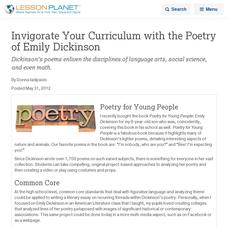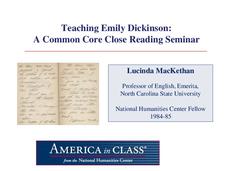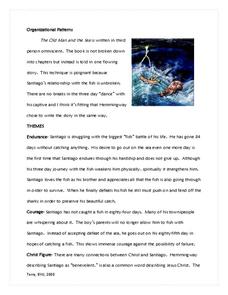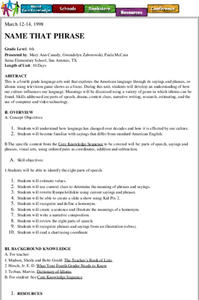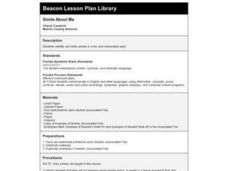Novelinks
Words by Heart: Guided Imagery
Sad, depressed, miserable, inconsolable, forlorn: so many synonyms have a lot of variety with their connotations. Through the guided imagery activity, writers explore the use of connotation and its influence on imagery and description by...
Novelinks
Zach’s Lie: Guided Imagery
Close your eyes and picture a time where you decided to tell the truth to someone. What were you wearing? How did you feel? Such prompts begin a guided imagery activity for Zach's Lie. Directions for creating an environment conducive to...
Curated OER
Invigorate Your Curriculum with the Poetry of Emily Dickinson
Dickinson’s poems enliven the disciplines of language arts, social science, and even math.
Gottlieb
Kennings vs. Stock Epithets – A Quick Review
Bone-crusher. Troll-wife. Battle-sweat. Blood-worm. What study of Beowulf would be complete without offering readers of this Old English epic poem an opportunity to craft their own kennings and epithets? Provide individuals with a copy...
National Humanities Center
Teaching Emily Dickinson: A Common Core Close Reading Seminar
Three of Emily Dickinson's poems, "I like to see it," "Because I could not stop for Death," and "We grow accustomed to the Dark," provide instructors with an opportunity to model for class members how to use close reading strategies to...
Curated OER
House and Holmes: A Guide to Deductive and Inductive Reasoning
Test your pupils' reasoning skills with several activities and a quick mystery to solve. Learners watch and analyze a few video clips that demonstrate reasoning in action, practice deduction with an interactive and collaborative...
Social Studies School Service
DVD Lesson Plan: Thirteen Days
Here you'll find a fine teacher reference for presenting the film Thirteen Days, a dramatic interpretation of the Cuban Missile Crisis during the Kennedy administration. It includes a brief description of the film, learning objectives, a...
Digital Writing and Research Lab's – Lesson Plans
Teaching Close Reading through Short Composition/Revision
This activity may have writers evaluate short compositions, but their subjects are quite tall: great Americans. Pupils read one another's compositions and closely examine how specific phrases and diction contribute to shaping American...
Curated OER
Goals
Do your learners need help setting financial goals? Do they need to practice setting long-term goals? Keep teens accountable by providing the goal contract and encouraging them to check in with their goals! Give middle and high schoolers...
August House
The Hidden Feast
What is a proverb? This is the leading question of this resource. First, explore proverbs and their meanings. Then, read aloud The Hidden Feast: A Folktale from the American South by Martha Hamilton and Mitch Weiss and partake in a grand...
Curated OER
Delve Into the Metaphorical Mind
There are many ways to teach metaphors — all are gold to our young learners.
UAF Geophysical Institute
System Interactions: The Lorax and the Truffula Tree
If the Lorax were to write a letter, what would he write? Introduce your class to systems and feedback loops through the whimsical stylings of Dr. Seuss. Learners take on the Lorax's point of view to write a letter, among other activities.
Channel Islands Film
Cache: Lesson Plan 4 - Grades 4-5
After viewing the West of the West's documentary Cache, individuals craft either a newspaper article chronicling the discovery of the cache on San Nicolas Island, a historical narrative of the placement of the cache in the cliff side, or...
Curated OER
Preparing For The First Day Of School
Youngsters analyze a book discussing a child's fear on the first day of school. They discuss the characters in the book, The Teacher from the Black Lagoon. Then they discuss their own fears and uncertainties about starting a class with...
Fusco’s English Class
Journal Writing Prompts
Inspire thoughtful journal entries with these detailed journal writing prompts. The resource includes 24 prompts that require learners to write expository, persuasive, and sometimes creative journal entires.
1 plus 1 plus 1 equals 1
I Can Read! Sight Words Set #8
Provide the building blocks to a strong education with a packet about sight words. Kids work on the words little, we, do, and all with tracing and matching activities, as well as games and flash cards.
Curated OER
The Old Man and the Sea: Concept Analysis
Use a helpful concept analysis guide when planning your unit on Ernest Hemingway's The Old Man and the Sea. The resource covers plot elements, literary themes, and possible issues to address in order to make the work accessible to all of...
Curated OER
Music to My Ears - Figures of Speech and Stylistic Devices
Students know the meaning of a given list of figures of speech and stylistic devices. They identify examples of these terms in the music and songs with which they are familiar. They examine how to apply the knowledge of these terms to...
Curated OER
Name That Phrase
Students identify the American language, how it has changed and effected culture, and become familiar with idioms. In this American language lesson, students study the eight parts of speech, identify literal and figurative speech, study...
Curated OER
Historical Figures
Student research a "Historical Individual" using the Internet. They print a minimum of five articles and organize them. They create a visual biography of their historical figure.
Curated OER
Symmetry in Nature and Congruent Shapes All Around
Second graders explore symmetry and congruent shapes. In this math activity, 2nd graders identify examples of symmetry and congruent shapes in nature. Students take photographs and create a multimedia presentation of symmetry and...
Curated OER
Geo Jammin' By DeSign - Day 3, Lesson 16: The ABC of Symmetry
Students follow directions in the ABC of Symmetry to make a butterfly which shows a line of symmetry.
Curated OER
Simile About Me
Students are introduced to similes and read various examples. Then students write their own similes to describe themselves and share them with the rest of the class.
Curated OER
Mighty Metaphors
Fourth graders explore metaphors and then complete a worksheet on which they write metaphors. They may illustrate the metaphors.




